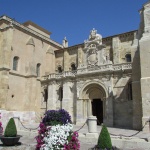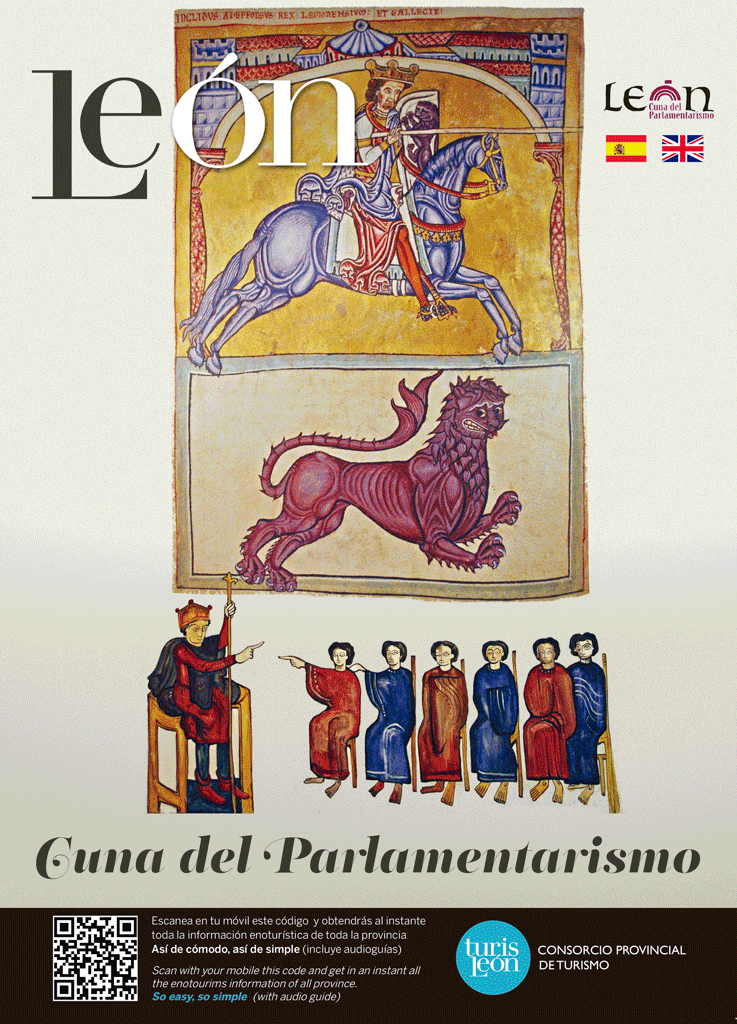ROYAL COLLEGIATE OF SAN ISIDORO
City: León
Plain and sturdy, the Royal Basilica of San Isidoro from León is one of the most complete and characteristic Romanesque structures. The previous building was erected upon order of the king Sancho el Craso, who in the 10th century decreed that a monastery be built to house the remnants of San Pelayo, Córdoba’s martyr child. The place chosen place was the Northwest point of the Legio VII Gemina Roman camp. Sancho’s sister, princess and nun Elvira Ramírez, moved to the new convent with her congregation from Palat de Rey. However, at the end of that century, Almanzor’s armies devastated the old monastery.
Alfonso V reconstructed it with clay and bricks, and established the royal cemetery there, guarded by the nuns. The bodies of King Alfonso’s ancestors, which had been scattered in different churches, were brought here, including the bodies of Alfonso V’s parents, Bermudo II and Elvira García.
His daughter, doña Sancha, later queen of León, and her husband Ferdinand I substituted the temple made of walls for a stone one, starting the Romanesque art in these lands. They both chose the church’s portico as royal cemetery. They decreed that they be buried in there when the time comes, next to the bodies of Saint Isidore and Saint Vincent. They had just been brought from Seville and Ávila, respectively.
The Puerta del Cordero (“Lamb’s gate”) is the gate to access the temple’s interior. It has a rounded arch and a beautiful tympanum, and it was finished off with an equestrian statue of Saint Isidore. To the right of the main access lies the Puerta del Perdón (“Gate of Forgiveness”), consecrated to pilgrims and contaning a unique Romanesque iconography: The Descent from the Cross, The Maries before the holy sepulcher and the Ascension. These images appear on both sides of the arch of Saint Peter and Saint Paul.
Inside the Royal Basilica, the atmosphere invites to meditation, due to the firm opacity of Romanesque style. The main altar, of Hispanic-Flemish style, contains a magnificent altarpiece from the 15th century whose center houses the throne where the Holy Sacrament is permanently exposed due to immemorial privilege.
The visit to the Royal Pantheon is essential. This extraordinary tomb of kings, queens and princes is sheltered by a vaulted ceiling covered in Romanesque paintings. These are considered the best painting collection of its style in the world. They make up a superb legacy that narrates the history of Redemption according to Mozarabic liturgy. This is all the more reason to call the pantheon “The Sisteen Chapel of Romanesque”.
Especial attention must be paid to the Pantocrator, the Pantheon’s central vault, where the figure of the Creator of the Universe appears surrounded by flames, clouds or waves. In the center, as usual, Christ in Majesty is shown blessing and with the book. He is inside the mystic mandorla, with a celestial vault in the background, plus the alpha and omega.
The other outstanding painting is the Agrarian Calendar. It appears in the arch’s soffit and is the most well-known work in the Pantheon. The true life of local people is shown in it, reflecting the typical farming activities of each month (wine harvest in September, pig slaughtering in November…)
The noon cloister was built in different epochs: one set of Romanesque arches, and three from the 18th century. The former remained hidden until the 20th century and it was restored in 1960 by Menéndez Pidal. It contains four arching openings with a double thread. There is also a smaller one as access opposite the temple’s gate.
The tower, with its rooster-shaped weather vane to round off the whole place, is one of the other very representative elements of San Isidoro. It was built in three stages: the first two ones were in the 11th century, conceived as part of the walled enclosure for defence. The next two stages correspond with the bell tower, in the 12th century. Finally, the cover is from the 18th century.
The Isidoran canonry was turned into the Instituto Secular Sacerdotal (“Secular Institute of Priests”) in 1956. From then on, this institution takes care of the intellectual life and liturgy of the Collegiate, the temple, its open museums, its Archive and Library (available for research), its Isidoran Editorial and Bookstore (which explain the history and art of the Collegiate) and also the figure of Saint Isidore.
Saint Isidore
Alfonso V el Noble (999 – 1028), King of León, the king of the “Bonos Foros”, raised a new Pre-Romanesque monastery out of brick and walls in the early 11th century. It was called San Juan y San Pelayo. Later on, the building was substituted by the one raised by Ferdinand I and his spouse Sancha, daughter of the aforementioned Alfonso V, in order to house the relics of Saint Isidore of Seville in 1063.
La Puerta del Cordero
It represents an exceptional group of sculptures, where the Mystic Lamb, Isaac’s Sacrifice, Saint Isidore’s and Saint Pelagius’ likenesses and zodiac signs predominate.
Roosters and bells
The first rooster-like weather vane of the tower is exposed at the chapel of the Vaca. It is the temple’s symbol, made in leaded copper covered in gold, as well as the bell, smelted in 1086 and thought to be the oldest one in Spain.
USEFUL DATA
More information:
IMAGES






